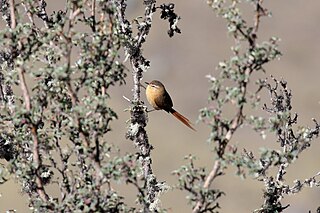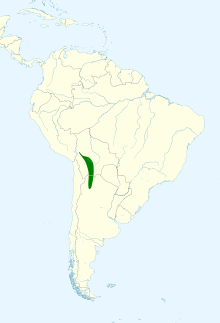
The tropical mockingbird is a resident breeding bird from southern Mexico to northern and eastern South America and in the Lesser Antilles and other Caribbean islands.

The chalk-browed mockingbird is a bird in the family mimidae. It is found in Brazil, Bolivia, Argentina, Paraguay, Suriname, and Uruguay.

The great dusky swift is a species of bird in subfamily Cypseloidinae of the swift family Apodidae. It is found in Argentina, Brazil, Paraguay, and possibly Bolivia.

The bamboo foliage-gleaner, also known as the crested foliage-gleaner or dusky-cheeked foliage-gleaner, is a species of bird in the Furnariinae subfamily of the ovenbird family Furnariidae. It is found in Bolivia, Brazil, Colombia, Ecuador, and Peru.

The maquis canastero, or canastero andino, is a species of bird in the Furnariinae subfamily of the ovenbird family Furnariidae. It is found in Argentina and Bolivia.

The white-winged cinclodes is a species of bird in the Furnariinae subfamily of the ovenbird family Furnariidae. It is found in Argentina, Bolivia, Chile, and Peru.

The plain inezia, or plain tyrannulet, is a species of passerine bird in the family Tyrannidae, the tyrant flycatchers. It is found in Argentina, Bolivia, Brazil, Paraguay, and Peru.

The tawny tit-spinetail is a species of bird in the Furnariinae subfamily of the ovenbird family Furnariidae. It is found in Argentina, Bolivia, and Peru.

The buff-banded tyrannulet is a species of bird in subfamily Elaeniinae of family Tyrannidae, the tyrant flycatchers. It is found in Argentina, Bolivia, and Peru.

The Patagonian mockingbird is a species of bird in the family Mimidae. It is found in much of Argentina and locally in Chile.

The Chilean mockingbird, locally known as tenca, is a species of bird in the family Mimidae. It primarily inhabits Chile's northern half, though there are sightings in Argentina.

The white-banded mockingbird is a species of bird in the family Mimidae. It is found in Argentina, Bolivia, Brazil, Chile, Paraguay, and Uruguay.

The San Cristóbal mockingbird or Chatham mockingbird, is a species of bird in the family Mimidae. It is endemic to San Cristóbal Island in the Galápagos Islands.

The Floreana mockingbird or the Charles Island mockingbird, is a species of bird in the family Mimidae. It was endemic to Floreana, one of the Galápagos Islands, but now is found only on two nearby islets, Campeón and Gardner-near-Floreana. The Floreana mockingbird is also known as Darwin's mockingbird, as it was the arguable inspiration for Charles Darwin's work on the origins of species; he noticed distinct differences between them and previous species he had encountered and consequently established the existence of other variants on neighboring islands.

The rough-legged tyrannulet is a species of bird in subfamily Elaeniinae of family Tyrannidae, the tyrant flycatchers. It is found in Argentina, Bolivia, Brazil, Paraguay, and Uruguay.

The southern scrub flycatcher is a species of bird in the family Tyrannidae, the tyrant flycatchers. It is found in Argentina, Bolivia, Brazil, Paraguay, Peru, and Uruguay. Other sources also place it in Guyana, Suriname, as a non-breeding visitor to Colombia, and as a vagrant in Ecuador.

The Amazonian scrub flycatcher or Todd's scrub flycatcher is a species of bird in the family Tyrannidae, the tyrant flycatchers. It is found in every mainland South American country except Argentina, Chile, Paraguay, and Uruguay.

Straneck's tyrannulet, also known as the monte tyrannulet and grey-crowned tyrannulet, is a small species of bird in the family Tyrannidae, the tyrant flycatchers. It is found in Argentina, Bolivia, Brazil, Paraguay, and Uruguay.

The dusky-capped woodcreeper is a species of bird in the subfamily Dendrocolaptinae of the ovenbird family Furnariidae. It is found in Bolivia and Brazil.

The Chaco puffbird is a species of bird in the family Bucconidae, the puffbirds, nunlets, and nunbirds. It is found Argentina, Bolivia, Brazil, and Paraguay.























